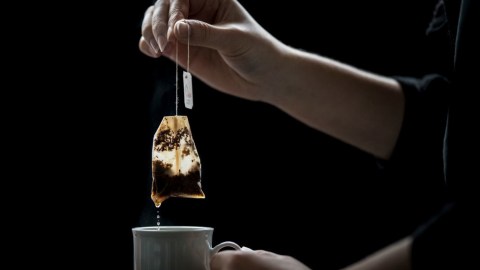Grocery store-bought tea bags release billions of microplastic particles into every cup

Image source: Illustration by Florian Gaertner / Getty Images
- A new study at McGill University discovered that many tea bags leach billions of plastic particles into every cup.
- While the health dangers are unknown, past research uncovered serious problems in other mammals when consuming such particles.
- Scientists estimate that between five and 13 million metric tons of plastic are dumped into oceans every single year.
When I initially shared a new study from McGill University that found plastic tea bags release billions of microplastics and nanoplastics on social media, most commenters asked, “Who drinks from plastic tea bags?” Many of us do, it turns out.
Discovering which companies use plastic tea bags takes some work, but the story isn’t exactly new. In 2013, The Atlanticreported on an increasing amount of tea manufacturers placing their leaves in “silky” or “mesh” tea bags. What appeared to be an evolution of the standard Lipton’s approach — you could see and smell the leaves — turns out to be potentially damaging to our health.
That’s what Nathalie Tufenkji, a professor of chemical engineering at McGill, thought one day when ordering a cup of tea at a Montreal café. Along with fellow researchers, she tested out four different tea bags constructed of plastic in her laboratory. The team discovered that, when brewed to 95 degrees Celsius, these bags release 11.6 billion microplastics and 3.1 billion nanoplastic particles into each cup.
Their findings were published in the journal Environmental Science & Technology on Sept. 25.
Some tea bags may shed billions of microplastics per cup
We know the damage that climate change is having on oceans — yet another report, this one issued by the United Nations, highlights how dangerously close we are to destroying ecosystems that most biological life on the planet depends on.
Plastic is also a pervasive problem in our world: since the ’50s, humans have produced over 8.3 billion metric tons of plastic, with roughly half of it being made over the last 15 years. Scientists estimate that between five and 13 million metric tons of plastic are dumped into oceans every single year. Warming temperatures and plastic particles create a perfect storm in the destruction of entire ocean habitats.
That’s not the only place plastics show up, the McGill team writes. Microplastics have been discovered in table salt, fish, and water — from taps, but even more so from plastic water bottles. They’re also being used in facial scrubs and toothpaste, along with, of course, drinking straws. In cafés around Los Angeles, I constantly witness cold brew coffee being served in plastic cups with plastic lids, sipped through with plastic straws that are delivered wrapped in plastic. I’m sure this practice is not limited to this city.
As the comedian, George Carlin, famously noted, maybe the purpose of humans was to put plastic on the planet. Given the data, his hypothesis may turn out to be correct.
Back to the McGill study, researchers steeped empty plastic teabags in reverse osmosis water for five minutes at 95 degrees Celsius. They then scanned the water using electron microscopy, confirming particle composition using two other forms of spectroscopy. The four brands used were all sourced from grocery stores and coffee shops in Montreal.

Photo by Zikri Maulana/SOPA Images/LightRocket via Getty Images
As of now, the health impact of consuming plastic particles is unknown in humans. Previous studies have confirmed environmental and health effects in populations of algae, zooplankton, fish, and mice. Numerous studies involving the mammalian gut (in rodents, rabbits, and dogs) show that plastic particles are translocated in the body once inside of the digestive tract. The team writes,
“Potential biological responses include genotoxicity, apoptosis, and necrosis, which could lead to tissue damage, fibrosis and carcinogenesis.”
As Taylor Orci wrote in The Atlantic in 2013, tea companies emphasize the quality of tea over the fact that you’re drinking plastic. Best to disguise the fact that these particles are being leached into consumer’s cups. That some companies advertise plastic-free teabags is telling of an industry-wide issue.
We’ll need more research to uncover the actual health effects of drinking these particles — between 2013 and 2019, no one has measured the harm of these substances, making you wonder what the FDA and CDC are doing. Regardless, it’s hard to square the benefits of green tea when you’re enjoying it with a side of plastic.

Image source: Nathalie Tufenkji et al. McGill University.
—
Stay in touch with Derek on Twitter and Facebook.





